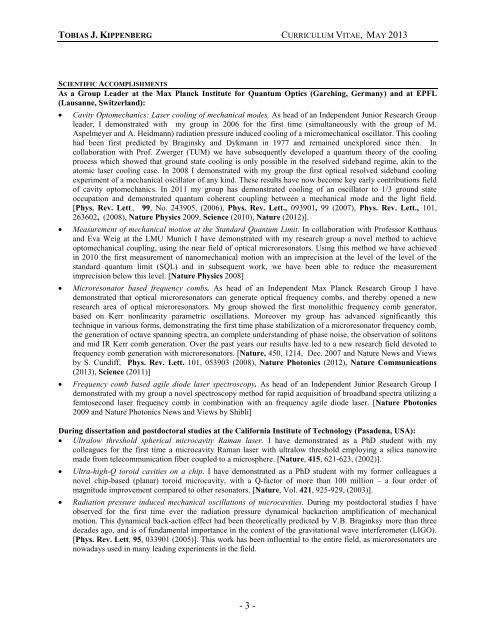Curriculum vitae - K-LAB - EPFL
Curriculum vitae - K-LAB - EPFL
Curriculum vitae - K-LAB - EPFL
Create successful ePaper yourself
Turn your PDF publications into a flip-book with our unique Google optimized e-Paper software.
TOBIAS J. KIPPENBERG CURRICULUM VITAE, MAY 2013<br />
SCIENTIFIC ACCOMPLISHMENTS<br />
As a Group Leader at the Max Planck Institute for Quantum Optics (Garching, Germany) and at <strong>EPFL</strong><br />
(Lausanne, Switzerland):<br />
• Cavity Optomechanics: Laser cooling of mechanical modes. As head of an Independent Junior Research Group<br />
leader, I demonstrated with my group in 2006 for the first time (simultaneously with the group of M.<br />
Aspelmeyer and A. Heidmann) radiation pressure induced cooling of a micromechanical oscillator. This cooling<br />
had been first predicted by Braginsky and Dykmann in 1977 and remained unexplored since then. In<br />
collaboration with Prof. Zwerger (TUM) we have subsequently developed a quantum theory of the cooling<br />
process which showed that ground state cooling is only possible in the resolved sideband regime, akin to the<br />
atomic laser cooling case. In 2008 I demonstrated with my group the first optical resolved sideband cooling<br />
experiment of a mechanical oscillator of any kind. These results have now become key early contributions field<br />
of cavity optomechanics. In 2011 my group has demonstrated cooling of an oscillator to 1/3 ground state<br />
occupation and demonstrated quantum coherent coupling between a mechanical mode and the light field.<br />
[Phys. Rev. Lett., 99, No. 243905, (2006), Phys. Rev. Lett., 093901, 99 (2007), Phys. Rev. Lett., 101,<br />
263602, (2008), Nature Physics 2009, Science (2010), Nature (2012)].<br />
• Measurement of mechanical motion at the Standard Quantum Limit. In collaboration with Professor Kotthaus<br />
and Eva Weig at the LMU Munich I have demonstrated with my research group a novel method to achieve<br />
optomechanical coupling, using the near field of optical microresonators. Using this method we have achieved<br />
in 2010 the first measurement of nanomechanical motion with an imprecision at the level of the level of the<br />
standard quantum limit (SQL) and in subsequent work, we have been able to reduce the measurement<br />
imprecision below this level. [Nature Physics 2008]<br />
• Microresonator based frequency combs. As head of an Independent Max Planck Research Group I have<br />
demonstrated that optical microresonators can generate optical frequency combs, and thereby opened a new<br />
research area of optical microresonators. My group showed the first monolithic frequency comb generator,<br />
based on Kerr nonlinearity parametric oscillations. Moreover my group has advanced significantly this<br />
technique in various forms, demonstrating the first time phase stabilization of a microresonator frequency comb,<br />
the generation of octave spanning spectra, an complete understanding of phase noise, the observation of solitons<br />
and mid IR Kerr comb generation. Over the past years our results have led to a new research field devoted to<br />
frequency comb generation with microresonators. [Nature, 450, 1214, Dec. 2007 and Nature News and Views<br />
by S. Cundiff, Phys. Rev. Lett. 101, 053903 (2008), Nature Photonics (2012), Nature Communications<br />
(2013), Science (2011)]<br />
• Frequency comb based agile diode laser spectroscopy. As head of an Independent Junior Research Group I<br />
demonstrated with my group a novel spectroscopy method for rapid acquisition of broadband spectra utilizing a<br />
femtosecond laser frequency comb in combination with an frequency agile diode laser. [Nature Photonics<br />
2009 and Nature Photonics News and Views by Shibli]<br />
During dissertation and postdoctoral studies at the California Institute of Technology (Pasadena, USA):<br />
• Ultralow threshold spherical microcavity Raman laser. I have demonstrated as a PhD student with my<br />
colleagues for the first time a microcavity Raman laser with ultralow threshold employing a silica nanowire<br />
made from telecommunication fiber coupled to a microsphere. [Nature, 415, 621-623, (2002)].<br />
• Ultra-high-Q toroid cavities on a chip. I have demonstrated as a PhD student with my former colleagues a<br />
novel chip-based (planar) toroid microcavity, with a Q-factor of more than 100 million – a four order of<br />
magnitude improvement compared to other resonators. [Nature, Vol. 421, 925-929, (2003)].<br />
• Radiation pressure induced mechanical oscillations of microcavities. During my postdoctoral studies I have<br />
observed for the first time ever the radiation pressure dynamical backaction amplification of mechanical<br />
motion. This dynamical back-action effect had been theoretically predicted by V.B. Braginksy more than three<br />
decades ago, and is of fundamental importance in the context of the gravitational wave interferometer (LIGO).<br />
[Phys. Rev. Lett, 95, 033901 (2005)]. This work has been influential to the entire field, as microresonators are<br />
nowadays used in many leading experiments in the field.<br />
- 3 -







